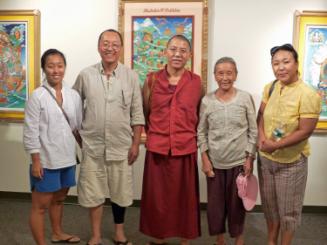Ambassadors of Folk Exhibit Panel
Date2010-2011
Mediumborn digital video
DimensionsDuration: 40 Seconds
ClassificationsGraphics
Credit LineConnecticut Cultural Heritage Arts Program collections
CopyrightIn Copyright
Object number2015.196.274.4
DescriptionVideo showing the title wall label for the exhibition, "Ambassadors of Folk: Connecticut Master Traditional Artists."
NotesSubject Note: "Ambassadors of Folk: Connecticut Master Traditional Artists" was an exhibit presented at the Institute for Community Research in Hartford, Connecticut, from June 10 through October 2010. Curated by the Connecticut Cultural Heritage Arts Program, the exhibit showcased the artistry of Connecticut folk and traditional artists who have achieved recognition on a national or international scale. The exhibit brought to wider attention the mastery of local artists who are highly respected exemplars of ethnic traditions within their communities. The eight visual artists and two performers featured represent a wide variety of artistic genres and ethnicities and share a high degree of technical skill and sophistication. The artists’ accomplishments represent entire lives spent serving their communities through cultural production. This exhibit celebrated the twenty years that the Connecticut Cultural Heritage Arts Program has worked with these and other remarkable traditional artists and their communities across the state.Artists included Aldona Saimininkas, East Hartford; Romulo Chanduvi, East Hartford; Jampa Tsondue, Old Saybrook; Eldrid Arntzen, Watertown; Paul Luniw, Terryville; Valentine and Aili Galasyn, Canterbury; Shengzhu Chen Bernardin, Torrington; Marek Czarnecki, Meriden; Fatima Vejzovic, Hartford; performers Negrura Peruana, East Hartford and Daniel Boucher, Bristol. Art forms exhibited drew from roots in Lithuania, Peru, Tibet, Norway, Ukraine, Finland, China, and Eastern Europe, but were all made and used here in Connecticut and beyond. One unifying characteristic is that these pieces have been created for use in a community’s traditional practices. For example, the Buddhist thangka paintings and the Byzantine Christian icons encourage active veneration, they serve a purpose beyond being paintings to be viewed. Other forms on display include decorative containers, cloth, commemorative pictures and rugs, wood carvings, and important seasonal decorations such as two types of dyed and etched Easter eggs. Performance traditions originate from African Peru and Québec. All of the art forms are beloved in the artists’ communities in Connecticut, where they serve as important expressions of cultural identity and heritage.
Additional audio, video, and/or photographic materials exist in the archive relating to these artists.
Cataloging Note: This project was made possible in part by the Institute of Museum and Library Services MA-245929-OMS-20.
Status
Not on viewJampa Tsondue
2018 March 10


